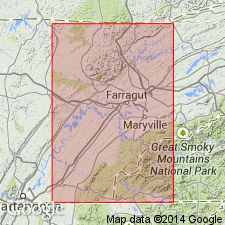
- Usage in publication:
-
- Bradley Creek Member
- Modifications:
-
- Named
- Dominant lithology:
-
- Limestone
- AAPG geologic province:
-
- Appalachian basin
Summary:
The Bradley Creek Limestone Member was proposed informally for the middle limestone of the Nolichucky Shale by Helton (1967: Univ. of TN Ph.D. thesis). It lies between unnamed upper and lower shale members. Because the unit is wide spread and easily recognizable, authors here formalize the name. Thickness of the member at its type section along Bradley Creek in northeast TN is 164 feet (50 m). It is characteristically sublithographic, with some coarsely crystalline oolitic or pelletal limestone. Bedding is typically massive, with some beds greater than 20 feet thick. Algal mounds occur in the lower part of the section. Throughout the outcrop area, thickness and lithology vary widely. In VA, the name Bradley Creek is applied only where the lower shale of the Nolichucky pinches out and the limestone becomes the basal member, overlying the Maryville Limestone; elsewhere in southwest VA, unit is referred to as the middle limestone of the Nolichucky. Eastward, the Bradley Creek merges into the Elbrook Dolomite. In the Greenville area, the Bradley Creek is a basinward extension of the basal Maynardville Limestone.
Source: GNU records (USGS DDS-6; Reston GNULEX).
For more information, please contact Nancy Stamm, Geologic Names Committee Secretary.
Asterisk (*) indicates published by U.S. Geological Survey authors.
"No current usage" (†) implies that a name has been abandoned or has fallen into disuse. Former usage and, if known, replacement name given in parentheses ( ).
Slash (/) indicates name conflicts with nomenclatural guidelines (CSN, 1933; ACSN, 1961, 1970; NACSN, 1983, 2005, 2021). May be explained within brackets ([ ]).

